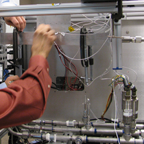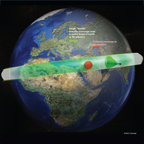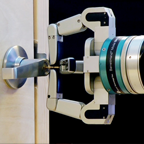| 2012/10/05 Making Connections At 45,000 Feet: Future UAVs May Fuel Up In Flight |
|
Currently global military aviation relies on a key enabler – aerial refueling. Fighters, bombers, reconnaissance and transport aircraft use “flying gas stations” to go the extra mile. Increasingly, UAVs are conducting combat and ISR operations, but UAVs aren’t designed to be refueled in flight. In 2007, DARPA teamed up with NASA to show that high-performance aircraft can easily perform automated refueling from conventional tankers, yet many unmanned aircraft can’t match the speed, altitude and performance of the current tanker fleet. The 2007 demonstration also required a pilot on board to set conditions and monitor safety during autonomous refueling operations. |
| 2012/10/02 Innovators Wanted: Could You Design the FANG Vehicle? |
|
The Defense Advanced Research Projects Agency (DARPA) is calling on innovators with expertise in designing and engineering drivetrain and mobility systems to collaboratively design elements of a new amphibious infantry vehicle, the Fast, Adaptable, Next-Generation Ground Vehicle (FANG). Registration is now open for the FANG Mobility/Drivetrain Challenge, the first of three planned FANG Challenges, which is set to kick off in January 2013. The winning team will be awarded a $1,000,000 cash prize and will have its design built in the iFAB Foundry. |
| 2012/09/28 Life at DARPA Innovation House Begins |
|
What happens when six teams of diverse, creative innovators are chosen to live and work together to try creative and ambitious approaches to hard technical challenges facing the Department of Defense? DARPA’s Innovation House Study, an experiment in collaboration and research that kicked off its 8-week sprint last week at George Mason University’s Arlington, Va., campus, is about to find out. |
| 2012/09/27 Electronics That Fight Infection and Dissolve Away |
|
DARPA researchers have created electronic systems and components using ultrathin sheets of silicon and magnesium encapsulated in silk. The thickness and crystallinity of the silk determines how long the electronics take to dissolve: days, hours, or even minutes. Silicon, and magnesium are naturally occurring at low levels in the human body, and since the amount of material used in these devices is below physiological levels, these electronics are biocompatible and eco-friendly. |
| 2012/09/20 Microfabrication methods to help navigate a day without GPS |
|
Military missions of all types need extremely accurate navigation techniques to keep people and equipment on target. That is why the Military relies on GPS or, when GPS is unavailable, precise sensors for navigation. These sensors, such as gyroscopes that measure orientation, are bulky and expensive to fabricate. For example, a single gyroscope designed as an inertial sensor accurate enough for a precision missile can take up to 1 month to be hand assembled and cost up to $1 million. DARPA has made progress in developing less expensive fabrication methods for inertial sensors and is making them orders of magnitude smaller and less expensive. |
| 2012/09/18 Tag Team Threat-recognition Technology Incorporates Mind, Machine |
|
For warfighters operating in the field, the ability to detect threats from standoff distances can be life-saving. When advanced radar and drone coverage is not available, warfighters typically rely on their own vision to scan their surroundings. Scanning over a wide area, though, is challenging because of the amount of territory that must be reviewed, the limited field of view of the human eye, and the effects of fatigue. Current technologies like binoculars, cameras, and portable radars can help to improve visibility and increase the threat detection rate. Unfortunately, current miss rates of 47 percent or greater using these technologies leave warfighters unprepared and vulnerable. |
| 2012/09/13 David and Goliath Engineered Into One Microstructural Improvements Enhance Material Properties |
|
Exquisite buildings like the Eiffel Tower were made possible because of advances in structural engineering design methods. Truss structures, like the Eiffel Tower, are highly efficient; they can carry the same loads as solid structures, but at approximately one tenth of the weight. This weight and strength advantage is also what enabled the dramatic increase in building heights between 1885 and 1930, when buildings went from an average of ten stories to more than 100 stories, as epitomized by the Empire State Building. With its novel structural engineering, construction of the Eiffel Tower ushered in the age of the skyscraper. |
| 2012/09/10 DARPA’s Four-Legged Robots Walk Out For Capabilities Demonstration |
|
Today, DARPA’s Legged Squad Support System (LS3) program demonstrated two robotic “pack mule” prototypes for the Commandant of the Marine Corps, Gen. James F. Amos, and DARPA Director, Arati Prabhakar. The first platform underwent its initial outdoor test earlier this year and has matured through continual testing and improvements to the point that two functioning platforms have started to run through the paces similar to what they could one day experience carrying gear for a squad of Marines or Soldiers. The goal of the LS3 program is to demonstrate that a legged robot can unburden dismounted squad members by carrying their gear, autonomously following them through rugged terrain, and interpreting verbal and visual commands. |
| 2012/09/05 DARPA’s Cheetah Robot Bolts Past the Competition |
|
DARPA’s Cheetah robot—already the fastest legged robot in history—just broke its own land speed record of 18 miles per hour (mph). In the process, Cheetah also surpassed another very fast mover: Usain Bolt. According to the International Association of Athletics Federations, Bolt set the world speed record for a human in 2009 when he reached a peak speed of 27.78 mph for a 20-meter split during the 100-meter sprint. Cheetah was recently clocked at 28.3 mph for a 20-meter split. The Cheetah had a slight advantage over Bolt as it ran on a treadmill, the equivalent of a 28.3 mph tail wind, but most of the power Cheetah used was to swing and lift its legs fast enough, not to propel itself forward. |
| 2012/08/30 Crowdsourcing Breakthrough Treatments for Blood Infections |
|
If asked how today’s toughest medical problems are being solved, most people would probably envision highly skilled physicians and scientists working countless hours with sophisticated lab equipment, not people sitting in their homes playing computer games. Yet DARPA feels the gamers of the world have something to contribute. By pooling the time of hundreds or even thousands of computer users, DARPA hopes to accelerate new research into better treatments for sepsis—an overwhelming infection of the bloodstream that affects thousands of servicemembers each year and often leads to death |
| 2012/08/29 Synchronized Tumbling: How To Catch A Retired Satellite |
|
In space, there are no brakes. Active satellites and spacecraft achieve controlled movement with thrusters. Retired satellites, on the other hand, no longer controlled from Earth, tumble in their orbits through space while traveling at high speed. A spacecraft seeking to rendezvous with such a satellite must perform a delicate dance to safely approach and synchronize movements. With the help of teams of individuals from around the world, DARPA is beginning to determine the steps required. Their work could inform the design of autonomous control mechanisms for all manner of complex future space operations. |
| 2012/08/16 Hiding in Plain Sight |
|
This robot is made of silicone. It can walk, change color and light up in the dark. It can even change temperature. And it can do all of this for less than $100. In the future, robots like this might be made for just a few dollars.
|
| 2012/08/16 Unmanned Sub-Hunter To Quell A Silent Threat |
|
The growing number of adversaries able to build and operate quiet diesel electric submarines is a national security threat that affects U.S. and friendly naval operations around the world. To address this emerging threat, DARPA recently awarded a contract for Phases 2-4 of its Anti-Submarine Warfare (ASW) Continuous Trail Unmanned Vessel (ACTUV) program to Science Applications International Corporation, McLean, Va.
|
| 2012/08/14 Digital Processors Limited by Power; What’s the UPSIDE? |
|
Today’s Defense missions rely on a massive amount of sensor data collected by intelligence, surveillance and reconnaissance (ISR) platforms. Not only has the volume of sensor data increased exponentially, there has also been a dramatic increase in the complexity of analysis required for applications such as target identification and tracking. The digital processors used for ISR data analysis are limited by power requirements, potentially limiting the speed and type of data analysis that can be done. A new, ultra-low power processing method may enable faster, mission critical analysis of ISR data. |
| 2012/08/08 Ultrafast Pulsed Lasers… More Than Just a Light show |
|
A Navy ship at sea is surrounded by water, with nothing but its carrier group in sight, and searches the skies for activity overhead. Isolated radars on each ship in the group scan independently of each other with limited effectiveness. But consider if all of the ships’ radars could be coherently linked to function as one. Such a capability would improve the range and resolution of each radar system, making it possible to identify and characterize objects further away and with greater fidelity. |
| 2012/07/31 DARPA Clears Path for Advanced Communications Sensors |
|
DARPA researchers have created the world’s first solid state receiver to demonstrate gain at 0.85 terahertz (THz). This is the latest breakthrough in the DARPA THz Electronics program in its quest for transistor-based electronics that will enable electronic capabilities at THz frequencies. This represents progress toward the second major technical milestone on the way to 1.03 THz integrated circuits. Previous milestones included demonstrations at 0.67 THz. Operating at these high frequencies enables a host of DoD electronics capabilities such as advanced communication and sensor systems. |
| 2012/07/30 Foundation Building DARPA Awards $15.3M in Basic Research Grants to Spur the Next Generation of Defense Innovators |
|
Innovation requires latitude to experiment and freedom to explore without fear of failure. Strategic innovation requires experimentation with a purpose. Every year since 2006, DARPA has awarded grants to promising academic scientists, engineers and mathematicians to foster strategic innovation in a defense context and, in the process, enhance basic research at colleges and universities throughout the United States. Under the auspices of the Young Faculty Awards (YFA) program, DARPA hopes to develop the next generation of researchers in key defense-related disciplines and encourage them to focus a significant portion of their careers on defense issues. |
| 2012/07/25 DARPA Makes 10 Million Strides in the Race to Contain a Hypothetical Pandemic |
 DARPA launched the Blue Angel program in 2009 as part of a U.S. Government-wide response to the H1N1 swine flu pandemic. As explained on DoD’s Pandemic Influenza Watchboard, in an influenza pandemic, DoD's mission is to preserve U.S. combat capabilities and readiness, and to support U.S. government efforts to save lives, reduce human suffering and slow the spread of infection.
|
| 2012/07/16 Student Competitors Sought for Cool Design Challenge |
 Recently, students from universities across the country traveled to the Johns Hopkins University Applied Physics Laboratory (JHU/APL) to participate in the first annual Field-Reversible Thermal Connector (RevCon) Challenge, sponsored by the Defense Advanced Research Projects Agency (DARPA) and the Office of Naval Research (ONR).
|
| 2012/07/12 To Extinguish a Hot Flame, DARPA Studied Cold Plasma |
|
Fire in enclosed military environments such as ship holds, aircraft cockpits and ground vehicles is a major cause of material destruction and jeopardizes the lives of warfighters. For example, a shipboard fire on the aircraft carrier USS George Washington in May 2008 burned for 12 hours and caused an estimated $70 million in damage. For nearly 50 years, despite the severity of the threat from fire, no new methods for extinguishing or manipulating fire were developed. In 2008, DARPA launched the Instant Fire Suppression (IFS) program to develop a fundamental understanding of fire with the aim of transforming approaches to firefighting. |
| 2012/07/10 This Fall, See Yourself as a DARPA Imagery Researcher |
|
There’s a lot to be said for the road that is taken—it’s safe, it’s well lit, and you probably know where it leads. Rarely does an opportunity present itself to leave the road entirely and venture off in search of new vistas. The Defense Advanced Research Projects Agency (DARPA) seeks trailblazers to explore the unknown in the areas of visual and geospatial data analysis. Researchers will participate in a short-fuse, crucible-style environment to invent new approaches to the identification of people, places, things and activities from still or moving defense and open-source imagery. |
| 2012/07/06 Hypersonics—The New Stealth |
|
DARPA’s research and development in stealth technology during the 1970s and 1980s led to the world’s most advanced radar-evading aircraft, providing strategic national security advantage to the United States. Today, that strategic advantage is threatened as other nations’ abilities in stealth and counter-stealth improve. Restoring that battle space advantage requires advanced speed, reach and range. Hypersonic technologies have the potential to provide the dominance once afforded by stealth to support a range of varied future national security missions. |
| 2012/07/05 DARPA Successfully Tests Gigapixel-class Camera |
|
This is an image of a gigapixel camera currently being developed by DARPA’s Advanced Wide FOV Architectures for Image Reconstruction and Exploitation (AWARE) program. As part of the program, DARPA successfully tested cameras with 1.4 and 0.96 gigapixel resolution at the Naval Research Lab in Washington, DC. The gigapixel cameras combine 100-150 small cameras with a spherical objective lens. Local aberration correction and focus in the small cameras enable extremely high resolution shots with smaller system volume and less distortion than traditional wide field lens systems. The DARPA effort hopes to produce resolution up to 10 and 50 gigapixels—much higher resolution than the human eye can see. Analogous to a parallel-processor supercomputer, the AWARE camera design uses parallel multi-scale micro cameras to form a wide field panoramic image. |
| 2012/07/02 How do you turn 10 minutes of power into 200? Efficiency, efficiency, efficiency. |
|
A robot that drives into an industrial disaster area and shuts off a valve leaking toxic steam might save lives. A robot that applies supervised autonomy to dexterously disarm a roadside bomb would keep humans out of harm’s way. A robot that carries hundreds of pounds of equipment over rocky or wooded terrain would increase the range warfighters can travel and the speed at which they move. But a robot that runs out of power after ten to twenty minutes of operation is limited in its utility. In fact, use of robots in defense missions is currently constrained in part by power supply issues. DARPA has created the M3 Actuation program, with the goal of achieving a 2,000 percent increase in the efficiency of power transmission and application in robots, to improve performance potential. |
| 2012/06/28 UAVForge Reveals Challenge Of Developing Perch And Stare UAV |
|
DARPA’s UAVForge, a crowdsourcing competition to design, build and manufacture an advanced small unmanned air vehicle (UAV), set out to determine if a loosely-connected community of UAV enthusiasts could develop a militarily relevant back-pack portable UAV with specific capabilities. By using a crowdsourcing design approach, the effort sought to inspire innovation and creative thought by lowering barriers to entry and increasing the number and diversity of contributors. |
| 2012/06/26 DARPA Develops Technologies For Aiding Disaster Relief |
 During natural or man-made disasters, the U.S. armed forces’ rapidly deployable airlift, sealift, communication, and medical evacuation and care capabilities can supplement lead relief agencies in providing aid to victims. The Department of Defense’s 2012 strategic guidance document includes humanitarian assistance and disaster relief operations as one of the missions for 21st Century defense.
|
| 2012/06/13 DARPA Staff Supports Wounded Warriors During 110 Mile Bike Ride |
|
Recently, DARPA staff finished a grueling 2-day, 110 Mile Bike Ride that started near DARPA headquarters in Arlington, Va. and ended in Gettysburg, Pa. The team took part in World T.E.A.M. Sports’ annual Face of America ride, which honors wounded warriors. DARPA staff rode as part of Team Strength & Honor which raised more than $39,000. The event attracted more than 500 riders, including more than 60 wounded warriors. Funds raised cover the costs for wounded warriors to participate in the ride and other World T.E.A.M Sports events. |
| 2012/06/08 DARPA Effort Targets Illness Faster Safer and More Effectively |
 In addition to keeping the warfighter safe while deployed in theater, there is a clear need to maintain warfighter health throughout their military service. For example, the Military Infectious Disease Research Program reports that more warfighters are hospitalized each year for infectious diseases than are wounded in combat.
|
| 2012/06/07 ICECool to Crack Thermal Management Barrier Enable Breakthrough Electronics |
|
The continued miniaturization and the increased density of components in today’s electronics have pushed heat generation and power dissipation to unprecedented levels. Current thermal management solutions, usually involving remote cooling, are unable to limit the temperature rise of today’s complex electronic components. Such remote cooling solutions, where heat must be conducted away from components before rejection to the air, add considerable weight and volume to electronic systems. The result is complex military systems that continue to grow in size and weight due to the inefficiencies of existing thermal management hardware. |
| 2012/05/24 Foundry Test-bed Identified |
 To innovate we must make, and to protect we must produce. This is a theme that ties together DARPA’s numerous advanced manufacturing efforts. One such effort, part of the Adaptive Vehicle Make (AVM) portfolio, is called Instant Foundry Adaptive through Bits (iFAB). iFAB seeks to create a foundry to rapidly design and reconfigure manufacturing capabilities to support the fabrication of a wide array of military vehicles.
|
| 2012/05/21 DARPA Blast Gauge Quantifies Blast Exposure, Leads to Advancements in Countering TBI |
|
Traumatic Brain Injury (TBI) is the signature wound of conflicts in Iraq and Afghanistan. Conservative estimates put the number of U.S. warfighters who have experienced TBI at more than 200,000. Battlefield medical personnel today rely on visual signs and the personal accounts of patients to alert them to the possibility of TBI. The DARPA Blast Gauge provides a quantitative means for measuring blast related exposure, thus providing a mechanism for medical personnel to better identify those at risk for TBI. The gauge collects quantitative data to provide medics with a screening tool and data for uncovering the mechanisms of TBI. |
| 2012/05/16 DARPA Collaboration Offers Hope to People with Tetraplegia |
|
DARPA launched the Revolutionizing Prosthetics program in 2006 to advance the state of upper-limb prosthetic technology with the goals of improving quality of life for service-disabled veterans and ultimately giving them the option of returning to duty. Since then, Revolutionizing Prosthetics teams have developed two anthropomorphic advanced modular prototype prosthetic arm systems, including sockets, which offer increased range of motion, dexterity and control options. Through DARPA-funded work and partnerships with external researchers, the arm systems and supporting technology continue to advance. |
| 2012/05/08 Revolutionary Approach for Controlling Sepsis Key to Saving Warfighter Lives |
|
Sepsis is an overwhelming blood infection, which when coupled with shock (such as that which may be experienced following a combat injury) has a mortality rate near 50 percent. Current methods to identify and treat sepsis may take 48 hours or longer – resulting in increased recovery time from combat wounds and hundreds of preventable deaths. |
| 2012/05/03 Can automated deep natural-language analysis unlock the power of inference |
 Much of the operationally-relevant information relied on in support of DoD missions may be implicit rather than explicitly expressed, and in many cases, information is deliberately obfuscated and important activities and objects are only indirectly referenced.
|
| 2012/05/01 DARPA Seeks Technology To See Through Clouds For Warfighter Support |
|
Warfighters who encounter enemy forces on the ground benefit from overhead aircraft support. Some capabilities are lost, however, when cloud-cover obscures the view. Typically, airborne weapon systems that use electro-optic (EO) sensors during support missions can’t “see” through clouds. DARPA’s Video Synthetic Aperture Radar (ViSAR) program seeks to develop and demonstrate an Extremely High Frequency (EHF) targeting sensor which operates through clouds as effectively as today’s infrared (IR) sensors operate in clear weather. |
| 2012/04/26 Energy Heat DARPA seeks non-thermal approaches to thin-film deposition |
|
When the Department of Defense (DoD) wants to build a jet engine, it doesn’t put a team of engineers in a hangar with a block of metal and some chisels. Jet engines are made up of individual components that are carefully assembled into a finished product that possesses the desired performance capabilities. In the case of thin-film deposition—a process in which coatings with special properties are bonded to materials and parts to enhance performance—current science addresses the process as though it is attempting to build a jet from a block of metal, focusing on the whole and ignoring the parts. Like a jet engine, the thin-film deposition process could work better if it was addressed at the component level. |
| 2012/04/24 DARPA Opens International Dialogue On Satellite Servicing |
|
Current satellites are not designed to be serviced in space. When a communication satellite in geosynchronous orbit (GEO) fails 36,000 kilometers above the earth, typically, it is moved into a “graveyard” orbit where it remains indefinitely. Many of the satellites which are obsolete or have failed still have usable antennas, solar arrays and other components which are expected to last much longer than the life of the satellite, but currently there is no way to re-use them. |
| 2012/04/23 DARPA’s Bob Colwell Honored by American Academy of Arts and Sciences |
 The American Academy of Arts and Sciences announced that Bob Colwell, deputy director, DARPA Microsystems Technology Office (MTO), will join its elite membership. Some of the others elected into the Academy this year are Hillary Rodham Clinton, Sir Paul McCartney, Clint Eastwood, Mel Brooks, Melinda F. Gates and Amazon founder Jeffery Bezos.
|
| 2012/04/20 Engineering Review Board Concludes Review of HTV-2 Second Test Flight |
 Following an extensive seven-month analysis of data collected from the Aug. 11, 2011, second flight of DARPA’s Hypersonic Technology Vehicle (HTV-2), an independent engineering review board (ERB) investigating the cause of a flight anomaly completed its report. The findings of the ERB validated the vehicle’s aerodynamic design and uncovered new information regarding the thermal material properties of the vehicle.
|
| 2012/04/16 New Sensor Sought to Enable Military Missions in GPS-denied Areas |
 Many U.S. Military systems, such as missiles, rely on the Global Positioning System (GPS) to provide accurate position, orientation and time information while in flight. When GPS is inaccessible, whether as a result of a malfunction or as a consequence of enemy action, information critical for navigation must be gathered using the missile's on-board sensors.
|
| 2012/04/10 DARPA seeks robot enthusiasts and you to face off for $2M prize |
 As iconic symbols of the future, robots rank high with flying cars and starships, but basic robots are already in use in emergency response, industry, defense, healthcare and education. DARPA plans to offer a $2 million prize to whomever can help push the state-of-the-art in robotics beyond today’s capabilities in support of the DoD’s disaster recovery mission.
|
| 2012/03/29 DARPA Seeks Integration of Diverse Microsystems Components on Silicon Chips |
 High-performance microsystems are vital for a wide variety of DoD systems that provide U.S. warfighters with technological surprise over adversaries in areas such as communications, sensing and electronic warfare. Current fabrication technology limits the types of materials and devices that can be integrated together, forcing circuit designers to make compromises when selecting devices for an integrated microsystem.
|
| 2012/03/29 DARPA Calls for Advances in Big Data to Help the Warfighter |
|
Warfighters missions rely on a virtual net of sensors and communications systems for greater battlefield awareness than at any time in history. At the same time, demands for actionable information have spiked as warfighters at every level—whether at the planning table or on patrol—are called upon to make well-informed decisions. To maximize mission effectiveness and enhance national security, the Department of Defense (DoD) is now challenged to more efficiently fuse, analyze and disseminate the massive volumes of data this network produces. |
| 2012/03/27 DARPA Chip-Scale Atomic Clocks Aboard International Space Station |
 Atomic clocks are the most accurate frequency standard and timing devices in the world. Their range of uses include being the international standard for timekeeping, managing broadcasts and satellite positioning, navigation and timing (PNT). Traditional atomic clocks are too large to be placed onboard small satellites so a downlink with Earth is needed for the accurate PNT required for space operations.
|
| 2012/03/22 No bumps in the road for DARPA’s robotic suspension system |
|
The use of ground robots in military explosive-ordinance-disposal missions already saves many lives and prevents thousands of other casualties. If the current limitations on mobility and manipulation capabilities of robots can be overcome, robots could potentially assist warfighters across a greater range of missions. DARPA’s Maximum Mobility and Manipulation (M3) program seeks to create and demonstrate significant scientific and engineering advances in robot mobility and manipulation capabilities. |
| 2012/03/16 DARPA Seeks Innovative Technologies For Assured Arctic Awareness |
|
The Arctic region is poised for greater regional significance as polar ice retreats in coming decades. Ship traffic likely will increase during summer months, and commercial activity focused on the sea floor is expected to grow. The Arctic is largely isolated, vast and environmentally extreme. Remote sensing may offer affordable advantages over traditional methods of monitoring the region—aircraft, satellites or manned ships and submarines—due to the great distances in the Arctic. |
| 2012/03/16 DARPA CLIQR Quest Ends |
 The dynamics of social networks have provided a platform for communication research for years. The introduction of social media channels has added an element of hyper-connectedness to that research, resulting in efforts to better understand how to leverage social media as a communication channel for timely mass information, rapid mobilization of groups, and wide-area team building.
|
| 2012/03/13 DARPA Don’t Try To Predict The Future Of Cyber Security Build It |
 To date, there has been much focus on increasing DoD cyber defensive capabilities. To be sure, the list of needed capabilities is long. DoD networks may be safer than they were, but systems are often easily penetrated, accounts are routinely hacked, intellectual property and sensitive information are compromised, and the supply chain is not secure.
|
| 2012/03/12 DARPA Director speaks of Offensive Capabilities in Cyber Security |
 Since 2009, DARPA has been steadily increasing its cyber research. Its budget submission for fiscal year 2012 increased cyber research funding by $88M, from $120M to $208M. Over the next five years, the Agency’s proposed cyber research investment is expected to grow from 8 to 12 percent of its top line.
|
| 2012/03/12 On-Demand Satellite Imagery Envisioned For Frontline Warfighters |
 Today, the lowest echelon members of the U.S. military deployed in remote overseas locations are unable to obtain on-demand satellite imagery in a timely and persistent manner for pre-mission planning. This is due to lack of satellite overflight opportunities, inability to receive direct satellite downlinks at the tactical level and information flow restrictions.
|
| 2012/03/05 DARPA Makes Room On International Space Station For Programmers |
|
Precision robotic activity in space, where there’s zero gravity, introduces both advantages and disadvantages. To date, large organizations with complex space systems have dominated this domain. For a small company or an individual this task is almost impossible. But bridging the gap to make the impossible a reality has long been a DARPA trait. For DARPA’s Phoenix program, which has as one of its aims the ability to repurpose components from dead satellites, these limits on space-based precision robotic activity represent one particular challenge that must be addressed for the program to meet its goals. |
| 2012/03/05 DARPA’s “Cheetah” Sets Land Speed Record for Legged Robots |
|
The use of ground robots in military explosive-ordinance-disposal missions already saves many lives and prevents thousands of other casualties. If the current limitations on mobility and manipulation capabilities of robots can be overcome, robots could much more effectively assist warfighters and other Department of Defense personnel across a greater range of missions. DARPA’s Maximum Mobility and Manipulation (M3) program seeks to create and demonstrate significant scientific and engineering advances in robot mobility and manipulation capabilities. |
| 2012/03/01 DARPA’s Robotics Simulator Test Platform Reaches 2nd Milestone |
 DARPA's Autonomous Robotic Manipulation (ARM) program is developing software to perform human-level tasks quickly and with minimal direction.
|